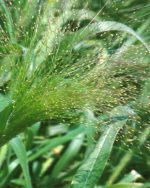
Witchgrass is a summer annual and a member of the grass family, Poaceae, that also includes corn, rice, and bamboo. It is native to most of North America from the East Coast to the West Coast of the US and can be found in disturbed sites including railroad tracts, road ditches, field margins, construction sites, vacant lots, and gardens. Plants prefer mesic to dry soil in full sun and tolerate alkaline soil.
Description: With a fibrous root system witchgrass grows ten to thirty inches tall and has multiple leafy stems that are usually spreading and branched from the base. The leaves are variably hairy, up to fifteen inches long, often drooping, and with wavy edges. The collars and ligules are hairy and the nodes are hairy and green to purplish. The flowers are carried in large open panicles that resemble a broom and may make up over half the total size of the plant. They appear from the end of summer into fall and give way to egg-shaped grains that are carried by the wind when the panicle dies, dries, and breaks off.
Control: Mulch to inhibit seed germination. Pull or hoe seedlings as soon as they appear. Pull, cut, or mow large plants before they set seed. In severe cases herbicides can be used: Bensulide, DCPA, Oxadiazon, Pendimethalin, and Prodiamine (preemergent); Fenoxaprop and Topramezone (postemergent)
f